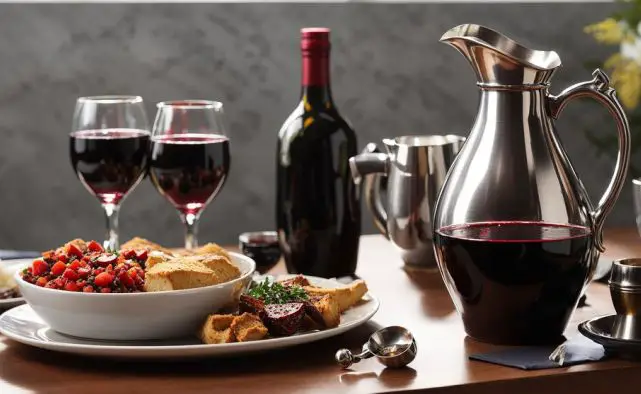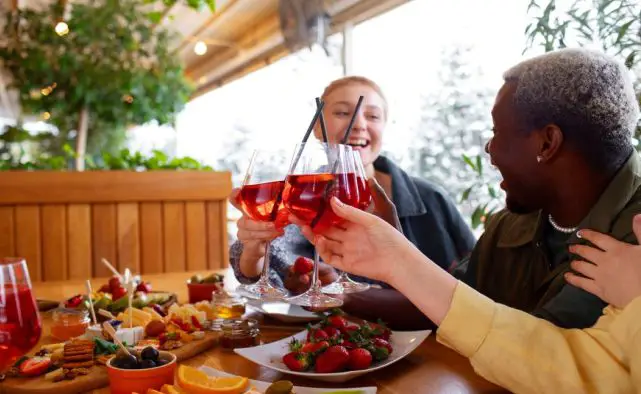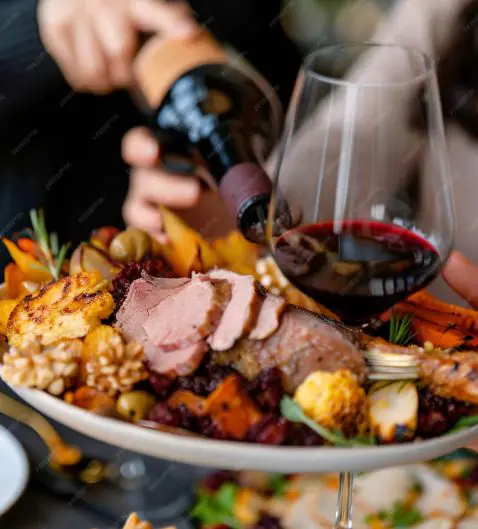Last updated on October 2nd, 2024 at 10:07 pm
Master the art of wine pairing with food and learn how to pair different wines with meals to enhance flavors. Here is everything you want to know.
Wine pairing with food is an art that adds to both the meal and the wine, creating a harmonious dining experience.
Understanding the basics of pairing can give a pleasant experience, whether you’re hosting a dinner party or enjoying a casual night in.
This guide breaks down the principles of pairing different types of wines with various foods, from light whites to full-bodied reds, helping you discover perfect combinations to delight your palate and impress your guests.
Recommended: The Four Basic Types of Wines
You might want to pin the image below.

Key Takeaways
- Gentlemen should understand wine basics, including types like red, white, rosé, and sparkling, to enhance their wine-pairing skills with food.
- Traditional wine pairing focuses on matching wine with specific foods based on regional or cultural customs for a harmonious dining experience.
- Principles of wine pairing involve matching wine intensity, flavours, acidity, and tannins with food to create a pleasant combination.
- Characteristics of wine varietals such as acidity, tannins, body, aroma, and sweetness impact food pairings, guiding gentlemen in creating complementary wine and food combinations.
Table of Contents
- Key Takeaways
- Introduction
- What is Traditional Wine Pairing?
- Principles of Wine Pairing with Food
- How the Characteristics of Each Wine Varietal Impact Food Pairings
- A Few Classic Wine Pairing Guide For The Gentleman
- Final Words from Gentsways
Introduction
To start on a gentleman’s journey into wine pairing, it is essential to understand the basics. Wine is made from fermented grapes, and each variety offers a distinct flavour profile.
The most common types of wines include
- Red wine
- White wine
- Rosé, and
- Sparkling wine
Reds tend to be more robust with flavours like blackberry, plum, and oak, while whites are often lighter with hints of citrus, pear, and floral notes.
Rosé wines boast of a delightful balance between reds and whites, presenting notes of strawberries and raspberries.
Sparkling wines, such as Champagne, are effervescent and have earned themselves as the celebratory drinks of the world. Sparkling wines can range in flavour from dry and crisp to floral and sweet.
Related: Understanding Wine Regions
What is Traditional Wine Pairing?

Traditional wine pairing is the practice of matching or pairing specific wines with certain foods hinging on guidelines depending on the tastes and characteristics of both the wines and foods.
It often follows regional or cultural customs, such as pairing red wine with red meat and white wine with fish or poultry.
Traditional pairings emphasize the complementing flavours of both food and wine to create a beautiful dining experience.
This approach relies on already-known rules that aim at promoting the enjoyment of both the food and the wine.
While traditional wine pairing is a solid ground for understanding the principles of wine pairing, modern opinions and personal preferences have also become increasingly valued in the world of wine and food pairing.
Related: Characteristics of White Wines
Principles of Wine Pairing with Food
There are some fundamental principles to keep in mind when pairing wine with food to ensure a successful combination that gives a pleasant experience:
1. Match the intensity of the wine with the intensity of the food to be paired
The wine and food to be paired should stand toe-to-toe in intensity. For example, a bold, full-bodied wine like Cabernet Sauvignon, would pair well with a rich dish like a steak or a stew.
At the other end, a light wine, such as a Pinot Grigio, would interact well with a lighter dish like seafood or salad.
2. Consider the flavours in both the wine and the food
Look for flavours in both food and wine that complement each other. For example, a spicy dish will pair well with a slightly sweet wine in the neighbourhood or rose, to balance out the heat.
Also, a dish with citrus flavours will interact better with wine with citrus notes.
Related: What is Wine Appreciation?
3. Think about the acidity of both the food and the wine
High-acid wines, like Sauvignon Blanc or Chardonnay, can do well with fatty and rich foods.
It’s a good match because acidic gulps will remove the fatty remnants, cleansing the palate between bites.
4. Don’t forget about the tannins in red wines
Tannins are active compounds present in the skins, seeds, and stems of grapes that present a dry, sour taste that leaves a puckering feeling in the mouth.
Fatty, salty and protein-rich foods can help to soften the tannins in red wines, making them more desirable.
5. Experiment to discover more
While there are some rules guiding wine and food pairing, there is no hard rules around it.
The best pairings are the ones you discovered yourself by experiment. Trust your palate and preferences when trying out new combinations.
Related: Gentleman’s Approach to Wine Etiquette
How the Characteristics of Each Wine Varietal Impact Food Pairings

A wine varietal is a specific type of grape variety used to produce wine taking into consideration the distinct flavours, aromas, and characteristics such as soil, climate or region unique to the grape variety from which they are made. The characteristics of each wine varietal can impact food pairings.
Here are some ways in which the characteristics of different wine varietals can influence the choice of food pairing:
1. Acidity
Acidity in wine increases its ability to dissolve fatty and greasy foods, refreshing the palate with each bite.
Acidic wines like Sauvignon Blanc or sparkling wines complement dishes with creamy sauces or oily textures.
Lower-acid wines like Merlot pair well with lighter fare to maintain harmony without overwhelming delicate flavours.
Related: The Art of Pairing Wines with Salmon
2. Tannins
Tannins are naturally occurring compounds in grape skins, seeds, and stems, found in red wines that contribute to the structure, texture, and behaviour of the wine. Tannins have astringent or drying feelings felt on the palate.
Tannins play a role in wine pairing, complementing and contrasting the texture and flavours of food. For instance, tannic red wines, like Cabernet Sauvignon or Nebbiolo, pair well with red meats or dishes with high protein content.
Related: Wine Pairing with Ham
3. Body and Weight
Wines can be categorized as light-bodied, medium-bodied, or full-bodied.
Light-bodied wines like Pinot Noir are often more delicate and go well with lighter dishes such as roasted vegetables, chicken, or salmon.
Medium-bodied wines like Merlot or Malbec pair well with dishes like pasta, grilled meats, or semi-hard cheeses.
Full-bodied wines such as Cabernet Sauvignon or Syrah go well with bold flavours, rich meats, or aged cheeses.
Related: Guide to Pairing Wines with Lamb
4. Aromatic Profile
Different wine varietals have distinct aromas and flavours.
For example, a Gewürztraminer may have floral and exotic fruit notes, while a Chardonnay can have buttery or oaky flavours.
These aromatic profiles can complement or contrast with certain dishes.
For instance, the floral and tropical character of Gewürztraminer can go well with spicy Asian cuisine, while the buttery notes of Chardonnay can complement dishes with rich sauces or seafood.
Related: All about the Red Wine
5. Sweetness
The sweetness level of a wine can impact food pairings.
Sweeter wines like Riesling or Moscato pair well with spicy or salty foods as the sweetness helps balance the flavours.
These wines can also pair well with fruity desserts. Dry wines, on the other hand, tend to go better with savoury dishes or less sweet desserts.
NOTE: It is important to note that the extent of acidity or tannins present in the wine should be balanced with the flavours and textures of the food. The goal is to find a harmonious combination where neither the wine nor the food overpowers one another, creating a complementary pairing. Experimenting and exploring different combinations is key to discovering the most enjoyable wine and food pairings.
Related: Everything to Know about the Sparkling Wine
A Few Classic Wine Pairing Guide For The Gentleman

1. Cabernet Sauvignon and Steak: The bold taste of Cabernet Sauvignon interacts well with the flavours of umami steak perfectly.
2. Chardonnay and Roasted Chicken: The creamy characteristic of Chardonnay interacts well with the softness of a roasted chicken.
3. Pinot Noir and Salmon: The silky texture of Pinot Noir promotes the flavours of grilled salmon, creating a harmonious pairing.
4. Sauvignon Blanc and Goat Cheese: The crisp characteristics of Sauvignon Blanc go well with the creamy and tangy taste of goat cheese, an excellent pairing for salads.
5. Merlot and Pasta with Tomato Sauce: The medium-bodied and fruity nature of Merlot interacts well with the acidity of tomato-based pasta dishes.
6. Riesling and Spicy Foods: The off-dry sweet taste of Riesling helps to cool down the heating spice from hot dishes, a pair of balance.
7. Syrah/Shiraz and Barbecue: The bold and smoky flavours of Syrah/Shiraz balance out the smoky and charred flavours of grilled meats, making it a great choice for barbecue dishes.
Related: Are Sparkling Red and Lambrusco the Same?
Frequently Asked Questions
Should a gentleman always follow traditional wine pairings?
A gentleman can respect tradition but should also embrace modern interpretations for a personalized and sophisticated dining experience.
How can a gentleman choose the right wine for a specific dish?
Consider the intensity and flavours of the dish, then match or contrast them with the wine’s characteristics for a harmonious pairing.
What should a gentleman do if he’s unsure about a wine pairing?
Seek advice from knowledgeable sources, consider the preferences of guests, and don’t be afraid to experiment with unconventional pairings for a unique experience.
What is the principle of wine pairing?
The principle of wine pairing is to match the intensity and flavours of the wine with those of the dish for a harmonious combination.
Final Words from Gentsways
Wine pairing is an art that can be enjoyed by gentlemen looking to elevate their dining experiences.
By understanding the different types of wine, the basic principles of pairing, the regional context, and the occasion, a gentleman can embark on a journey of sophistication and refinement.
However, a true connoisseur will also embrace experimentation and personal preferences, creating unique and unexpected pairings that delight the palate.
So, gentlemen, raise your glasses and embrace the world of wine pairing—a pursuit that embodies elegance, knowledge, and the pursuit of exceptional taste.
References:
- https://www.thegentlemansjournal.com/article/a-gentlemans-guide-to-choosing-wine-in-a-restaurant/
- https://thegentlemendiary.com/2023/06/the-gentlemans-guide-to-wine-how-to-choose-taste-and-pair/
Pyo Merez is a men’s lifestyle enthusiast and writer about the gentleman’s place and impact on society. Raised by a distinguished gentleman dad, he offers unique insights into how the mind of a gentleman works and how societal norms shape gentlemen’s identity and vice versa.
Through his insightful articles, Pyo taps into the depths of gentleman culture to provide perspectives on etiquette and manners in modern society.

